ျမိဳ႔ပတ္ရထား နဲ႔ ဝါးတားဘတ္စ္ စီးျပီး ရန္ကုန္ျမိဳ႔ၾကီးကို အသြင္သစ္တစ္မ်ိဳးျဖင္႔ ျမင္ၾကည္႔ျခင္း။ ??️![]() ❤️
❤️![]()
Yangon Circular Train
It was a cloudy Sunday afternoon when we decided to see Yangon’s colorful life by riding the Yangon Circular Train and newly launched Yangon Water Bus. Although we had already covered other public transportation like sidecar (trishaw) ride and bus ride (which is fun and which give a slower view of the local life in the hustle bustle of Yangon commercial city), but we had never tried circular train before and I had also been waiting to experience the water bus ride so we scheduled to experience both in the same day.
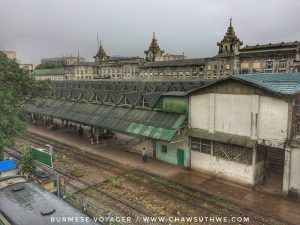
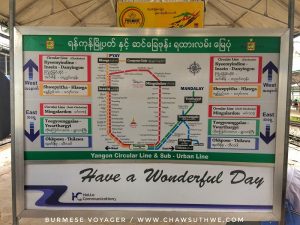
We headed to Yangon central railway station located at the corner of Pansodan road and Bogyoke Aung San Road. We walked on the Pansodan Bridge and took the stairs going down from the middle of the bridge through the gates of railway station. We went onto platform number 7 as a guard directed us to buy train tickets. Yangon central railway station was bustling with local people who were waiting for the trains and kids were playing around on the platforms.
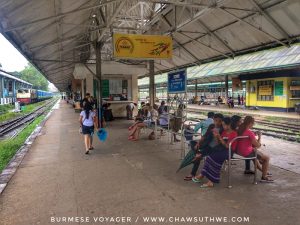

The Yangon Circular Train was built by the British in 1954 and it covers a railway track loop of 45.9 kilometers and stops at 39 stations. The employee at ticket counter explained very patiently about the circular train. The whole journey takes three hours to complete the loop and there are trains in both clockwise (Right) and counter-clockwise (Left) direction, running at regular intervals. The railway sells 100,000 to 150,000 tickets daily. We bought two tickets for 200 kyats each. At that moment, we had no idea where to wait for the train that will arrive at 1:05 PM to go clockwise. Very kind and friendly Burmese local people pointed us towards the train which was coming in a few minutes. We hopped on the train and took a seat.
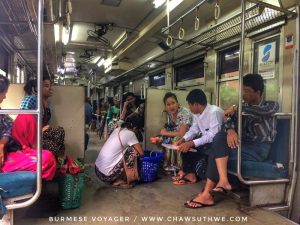
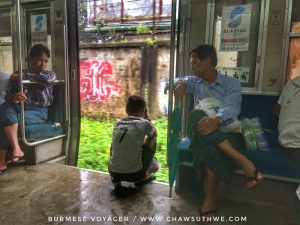
Women were balancing goods on their heads and men were carrying their stuffs in their hands. As we boarded the train to the clockwise, carriage was almost full with people. The train started moving slowly on bumpy tracks. The train condition was bad as it needed repair. Train stopped at each and every station for some minutes and people rushed to load and offload their belongings. Some local ladies were just napping and enjoying their stress free life style. As it is the cheapest mode of transportation in Yangon, one can see a cross section of Yangon life in it.
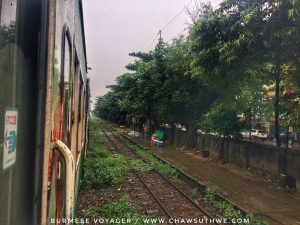
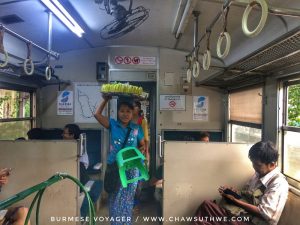
Vendors were selling fruits and different kind of snacks on the train. Some people bought the snacks and were passing time. The train was moving very slowly and we weren’t sure how we were going to stay on this train for the next 3 hours.
The train slowly moved further and the landscapes kept changing from city concrete to fields and suburban area. The more station we passed the more passengers the train picked up. Whenever the train stopped, people were loading their bags onto the floors of the carriage and after some time the floor was filled with vegetables, fruits and other items.
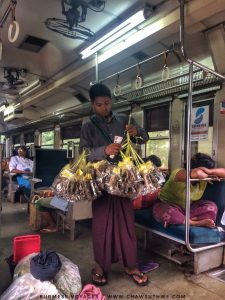
As the train passed, one could see the flooding fields, damaged housings and floating rubbish. It was a cloudy day so everybody looked relaxed on the train, except the busy vendors who were selling boil eggs, fruits and snacks. Although there was nothing fancy on the train, its draw for us was the peek into the lives of normal citizens and it was simply amazing.
After 1 hour of ride, it seemed painfully slow. So, we decided to get down at Insein Stop. The journey is unique that one can interact with the locals and witness their daily routine. Riding Yangon circular train gave us the chance to see the different landscapes of Yangon and the lifestyles of local people.
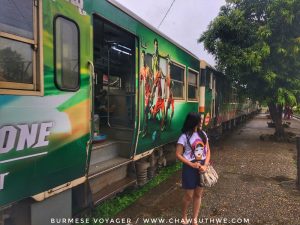
Next we planned to experience Yangon Water Bus ride so we asked a motor bike taxi to take us to Insein Water Bus Jetty from Insein train station. We both sat behind the bike driver and it took us 10 minutes to reach the jetty. Bike ride gave us a different local transport experience and it cost only 2000 kyats.
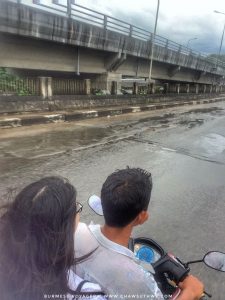
Yangon Water Bus
These recently launched water buses run on Yangon River and they stop at six jetties – Botahtaung, Pansodan, Lanthit, Kyee Myindaing, Shwe Padauk and Insein. There are two types of water bus services, one is called ‘All Stop service’ and another is ‘Express service’. All stop service water buses stop at all jetties and express service buses run between Botahtaung and Insein directly. Insein water bus jetty is built besides a bridge and the view there was awesome. When we approached the ticket booth and asked about the tickets, they told us to wait for sometimes. We checked the timetable for the next water bus and found that we still have 15 minutes. We passed our time at a cafeteria within the jetty that sold tea, Mohinga and coconut noodle. There is a food booth that sold lunch boxes at very fair price. These lunch boxes seemed to be a convenient option for local working people who were short of time.
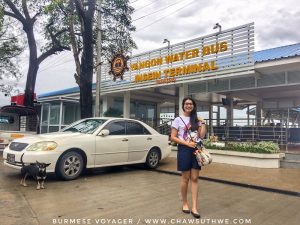
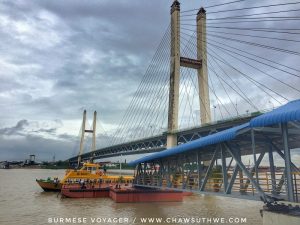
A cup of tea, Yangon river view and the fresh breeze was perfect for that moment. After a few minutes, ticket booth announced to queue for buying tickets. It wasn’t a long queue and cost was only 300 kyats per person for one way express water bus. Insein Jetty is the last stop out of six and many people who were coming from the first stop bought new tickets to return back. As it is a newly launched public transport and it was a weekend, we were expecting a crowd but we were fortunate that not too many people were there at that time. Some people, like us, were using Yangon water bus as a joy ride.
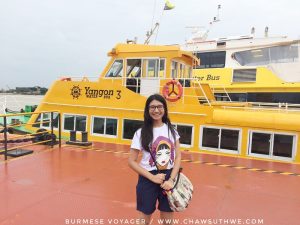
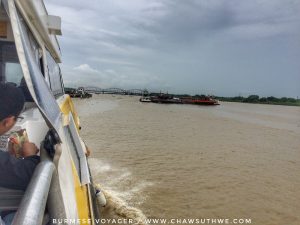
People going to places along the river side have more benefits in taking Yangon water bus instead of normal city bus, as the water bus is faster. People use the normal city buses for going all around the city as the water bus is running only on a limited stretch of the river.
After queuing for a few minutes and after showing the tickets for boarding, we crossed over a boardwalk to the water bus. A yellow color water bus looked like a yacht and it was new and shiny. People were boarding this double decker water bus and we decided to go on the upper deck for a better view. The seating comprised of metal benches kept in parallel, one behind another, on both side of a central aisle. We sat on a white mental bench near the rail, looking over the river.
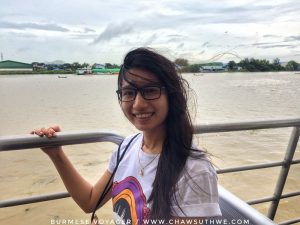

After filling up the passengers, the water bus captain announced for the departure and it started moving. Here we saw a different view of Yangon from the river and different local lifestyles on the water bus. One side of the river is commercial city Yangon, displayed with modern buildings and bustling with people and boats. One side is filled with villages and their boats. Different sized ships were stopping at various harbors and some ships were busy with loading the containers.
We were seated at a place where the moving boat was causing small water drops to splash on us. I moved a little bit inside of the bench but my travel partner enjoyed this little drizzle. Most of the people on the water bus were busy taking pictures. I think there was tea and snack vendor at the lower deck as I saw some people coming up to our deck with tea in their hands. People were chatting, enjoying the tea and the ride. I didn’t go down to the lower deck to check out this shop as I was afraid that if I stand up while the boat was moving, I might fall in the river.
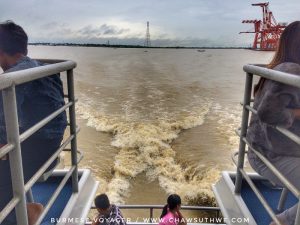
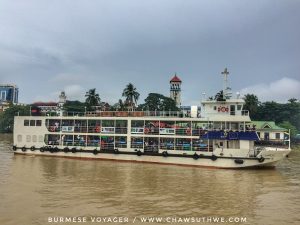
Being on the river made me feel so fresh and the scenery was also different from the view that we saw on circular train. As it was an express water bus, captain announced ‘We reached at Pansodan Jetty, if there is nobody to get down at this jetty, we will move on’. It seemed that even the express bus could be stopped if there was a passenger willing to get down at a midway jetty. But we noticed that people rarely got down midway and were mostly enjoyed the ride.
Yangon water bus, one of the cheapest transportation in Yangon, offers a pleasure of cruise ride. Yangon water bus may not be like luxury type cruise but I am sure that it offers the same beautiful view of the modern buildings and sceneries of Yangon. One benefit of using water bus as transportation is that one will never get stuck in traffic jams. Also there is not much crowd or noise while travelling.


We discovered the spectacular sceneries of Yangon’s waterways and rich historical and cultural landscapes that lie along the banks of Yangon River. As our water bus approached the last jetty Botahtaung, we could see seagulls flying around boats. There was another water bus which was ready to leave and we could see a lot of people getting into that. I think that was the ‘all stop service’ water bus going towards Insein. ‘All stop service’ water bus has only one deck and it is bigger in size and longer than the one that we took. Botahtaung jetty is next to the magnificent Botahtaung Pagoda and it seems like an apt way to end this nice ride.
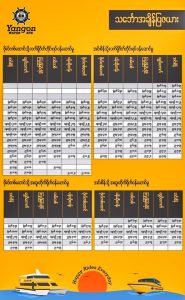

Our half day spent to experience different Yangon public transportation was completely worth it. Slow ride through Yangon with Circular Train gave us the chance to see a slice of Yangon life and the fun ride on Yangon River with water bus gave us the experience of seeing the beauty of Yangon from a different perspective. Circular Train and water bus are the life lines of Yangon city which keep its heart beating with the rhythm of life.
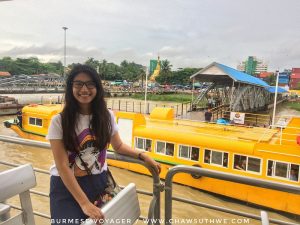
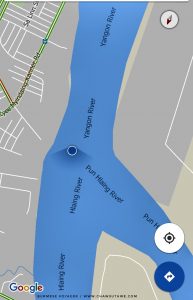

thank you for making this article very useful and keep up the good work